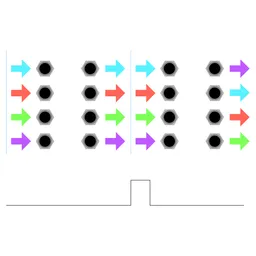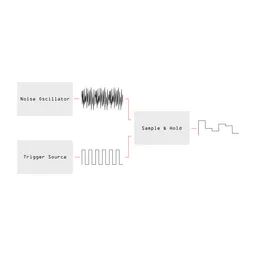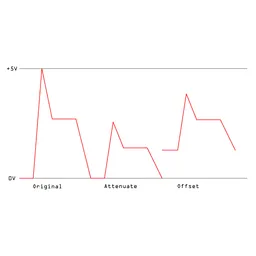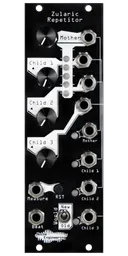Welcome back to Getting Started, the series where we explore the fundamentals of Eurorack and discuss different concepts and modules, how to use them, and how they fit into a system and a patch. And of course, it wouldn’t be a Noise Engineering blog without some wackiness, so at the end of each post we’ll discuss a more advanced/abstract/unusual technique for you more experienced patchers out there.
Today, we’ll be discussing gate signals and their similar-but-different counterparts trigger signals. When should you use one? When should you use the other? Does it matter? Read on.
BINARY SIGNALS IN EURORACK
Both gates and triggers are binary signals, meaning they’re either on or off. In Eurorack, everything is voltage, so “off” means 0 volts, and “on” generally means something like 5 to 10 volts. Gates and triggers are some of the simplest types of signals you’ll see in Eurorack, but they’re also some of the most important. Now, if both of these signals are just on or off, how can they be that different from each other? And how is such a simple signal even useful? Let’s talk a bit about each one’s characteristics and uses.

OFF AND ON WITH A HIGH POINT IN THE MIDDLE: GATES ARE A LOT LIKE MOST OF MY HIGHSCHOOL RELATIONSHIPS
As we mentioned earlier, a gate signal can be either high or low, but the key aspect of a gate is the amount of time that it’s high. Its length can be used to control a number of things, like how long an ADSR envelope sustains (read more about envelope generators here).
A gate signal can come from a few places: for instance, if you’re using a keyboard with your modular, it’ll likely have a gate output that goes high when a key is held down and low when that key is let go. It could also come from a sequencer -- either a dedicated gate sequencer, or more commonly, from a complex sequencer with gate and CV outputs that work in tandem to control voices.
Generally, clock signals in Eurorack just use triggers. But sometimes, clock dividers also output gates: for instance, if we have a module that divides an incoming clock by 16, it may output a high gate for 8 clock inputs, then a low gate for the next 8 inputs. Clock signals like this are useful for patches that involve logic, or for firing off complex envelopes... But we’ll talk more about clocking and logic later in this series.

LIKE A GATE, BUT SHORT: TRIGGERS
Triggers are, simply put, very short gates. Their length doesn’t matter, and they’re usually around 2-5ms. They’re used to trigger things (or “tell” them to do something) like drum modules, or simple decay or attack/decay envelopes that don’t sustain. They can also be used for more utilitarian things like advancing sequencers or switches.
If you wanted to sequence some drum modules, you’d probably use a dedicated trigger sequencer. However, sequencing isn’t the only thing triggers are used for: as we mentioned before, clock signals are usually triggers, too. The useful thing about this is that you can use your clock signals not only to clock things, but also to trigger things in a repetitive fashion -- I enjoy doing percussion sequencing sometimes just by using some clock dividers and multipliers.
You also may find interesting trigger outputs on modules that fire when, for instance, an envelope finishes a stage, or when a module changes state. These types of trigger outs can be used to cause chain reactions in large patches, creating events that cascade from module to module.
Now, you may be wondering, where’s the distinction? When does a gate signal become a trigger? The reality is that there’s no dividing line -- sometimes you’ll want a really short gate, and sometimes you’ll end up with a trigger that’s on the longer side. The distinction comes about more in how the signals are used.
CAN I USE A GATE AS A TRIGGER? HOW ABOUT THE OTHER WAY AROUND?
Good question! In most cases, modules that have trigger inputs don’t actually care about how long the trigger is: they just want a signal that goes from low to high. This means that a lot of the time you can use a gate signal as a trigger signal, too.
The opposite tends to be less compatible, however. Technically, a trigger is just a very short gate signal, so you may find instances where a trigger is exactly what you want at a gate input. However, that’s a bit more rare, as, if it is a true gate input, you’ll usually want some control over gate length.
It’s also important to note that sometimes the terms are interchangeably when talking about certain modules -- if that’s the case, you’re probably looking at something that uses triggers.
GATE SEQUENCERS VS. TRIGGER SEQUENCERS
Now, given that we just said that gates can often be used as triggers, you may think that a dedicated trigger sequencer would be impractical, since we could use a more widely applicable gate sequencer to control triggerable modules, as well as modules that expect gates.
However, workflow is always a key thing to consider when building a Eurorack system. Something like a gate sequencer designed for creating melodies and a trigger sequencer designed for writing rhythms will often function very differently from each other, and have different ways of inputting sequences.
That said, I’ve definitely used my main melodic gate/CV sequencer to sequence drums, and I’ve also used my drum sequencer to sequence melodic elements in my patches. The great thing about modular is that you can really do whatever you want to! There’s no right or wrong way to do things in modular, just choices for how you want your patches to work.
Looking for modules?
Here are just a few modules that can perform some of the functions we've been chatting about. There are always lots of choices in modular!
Noise Engineering Fractio Solum: A clock divider and mutliplier that outputs triggers.
Noise Engineering Zularic Repetitor: A four-channel trigger sequencer with hands-on control over trigger patterns.
Malekko Heavy Industry Varigate 4+: A four-channel, 8-step gate sequencer.
FOR ADVANCED PATCHERS: GATE TO TRIGGER/TRIGGER TO GATE CONVERSION
Ever needed to make a trigger signal longer? Or needed to make a gate signal shorter? Have no fear, envelopes are here!
Trigger and gate inputs on modules are generally looking for voltage to go above and below a threshold. Let’s say that threshold is 3 volts: it doesn’t matter if we input a perfectly square gate signal, or something curved like a sine wave: as soon as the signal goes above 3 volts (also known as rising edge), the module knows it’s being triggered, and when that signal goes below 3 volts again, it knows it’s not being triggered anymore. This means that we can really use any type of signal we want to trigger and gate things.
And that’s where envelopes come in: if you have a trigger signal but want to extend it for use with something that likes a long gate signal, for instance, you can use a long decay envelope. And if you have a gate signal, but you want to make it short like a trigger, you can use a short decay envelope.







